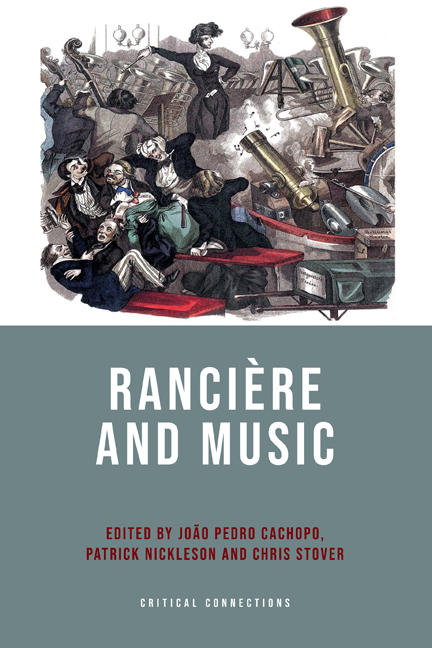Book contents
- Frontmatter
- Contents
- List of Examples
- Acknowledgements
- Notes on Contributors
- Introduction
- Part I: Music and Noise
- 1 Musique concrète and the Aesthetic Regime of Art
- 2 ‘Rip it up and start again’: Reconfigurations of the Audible under the Aesthetic Regime of the Arts
- 3 A Lesson in Low Music
- Part II: Politics of History
- 4 Wandering with Rancière: Sound and Structure under the Aesthetic Regime
- 5 Staging Music in the Aesthetic Regime of Art: Rancière, Berlioz and the Bells of Harold en Italie
- 6 Rancière on Music, Rancière’s Non-music
- 7 Coloured Opera and the Violence of Dis-identification
- Part III: Politics of Interaction
- 8 Musical Politics in the Cuban Police Order
- 9 Rancière and Improvisation: Reading Contingency in Music and Politics
- 10 Rancière’s Affective Impropriety
- Part IV: Encounters and Challenges
- 11 Rancière, Resistance and the Problem of Commemorative Art: Music Displacing Violence Displacing Music
- 12 Stain
- 13 On Shoemakers and Related Matters: Rancière and Badiou on Richard Wagner
- 14 Roll Over the Musical Boundaries: A Few Milestones for the Implementation of an Equal Method in Musicology
- Afterword
- A Distant Sound
- Works Cited
- Index
5 - Staging Music in the Aesthetic Regime of Art: Rancière, Berlioz and the Bells of Harold en Italie
Published online by Cambridge University Press: 03 October 2020
- Frontmatter
- Contents
- List of Examples
- Acknowledgements
- Notes on Contributors
- Introduction
- Part I: Music and Noise
- 1 Musique concrète and the Aesthetic Regime of Art
- 2 ‘Rip it up and start again’: Reconfigurations of the Audible under the Aesthetic Regime of the Arts
- 3 A Lesson in Low Music
- Part II: Politics of History
- 4 Wandering with Rancière: Sound and Structure under the Aesthetic Regime
- 5 Staging Music in the Aesthetic Regime of Art: Rancière, Berlioz and the Bells of Harold en Italie
- 6 Rancière on Music, Rancière’s Non-music
- 7 Coloured Opera and the Violence of Dis-identification
- Part III: Politics of Interaction
- 8 Musical Politics in the Cuban Police Order
- 9 Rancière and Improvisation: Reading Contingency in Music and Politics
- 10 Rancière’s Affective Impropriety
- Part IV: Encounters and Challenges
- 11 Rancière, Resistance and the Problem of Commemorative Art: Music Displacing Violence Displacing Music
- 12 Stain
- 13 On Shoemakers and Related Matters: Rancière and Badiou on Richard Wagner
- 14 Roll Over the Musical Boundaries: A Few Milestones for the Implementation of an Equal Method in Musicology
- Afterword
- A Distant Sound
- Works Cited
- Index
Summary
Art is art insofar as it is also non-art, or something other than art.
Rancière, Aesthetics and Its DiscontentsA scene is missing
This essay explores the hypothesis that bringing Rancière’s political- aesthetic ideas to bear on matters of music may productively unsettle and enrich our understanding of musical modernity. Such an exploration is both timely and risky. It is timely because Rancière has consistently reflected on the politics of art in the context of a reappraisal of artistic modernity that pays particular attention to the erosion of the arts and their connection to life – a debate in which the role of music should not be underestimated. Still, it is risky, albeit worthwhile, because Rancière's references to music have been somewhat sporadic and elusive. The above-mentioned hypothesis thus takes on the form of a double challenge: to venture into a less explored area in Rancière's thought while also – indeed, with the main goal of – developing new insights into the history and politics of music.
In order to tackle this challenge, my approach will be neither philological nor systematic. That is to say, I will neither delve into the texts in which Rancière deals more specifically with musical issues, nor attempt to apply aspects of his theorisation – say, the three regimes of art or the politics/police binary – to the history and practice of music. Instead, turning to what I consider to be a pivotal element of his undisciplined thought, I will draw on the ‘method of the scene’. If, for Walter Benjamin, method is ‘detour’ [Umweg], it might be fair to say that method is ‘staging’ [mise en scène] for Rancière. As he explains, the setting of a scene involves a number of theoretical operations, all of which are found at work in each of the fourteen chapters of Aisthesis: Scènes du régime esthétique de l’art (2011):
Each one of these scenes thus presents a singular event, and explores the interpretive network that gives it meaning around an emblematic text. The event can be a performance [représentation théâtrale], a lecture, an exhibition, a visit to a museum or to a studio, a book, or a film release.
- Type
- Chapter
- Information
- Ranciere and Music , pp. 117 - 137Publisher: Edinburgh University PressPrint publication year: 2020



